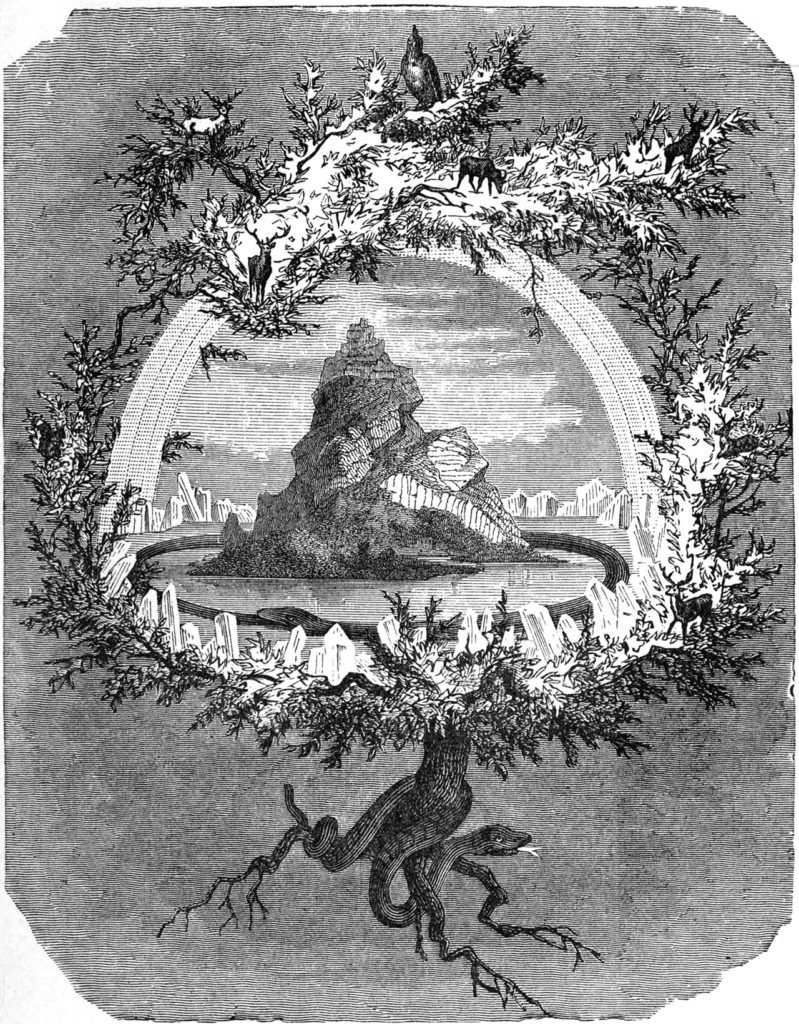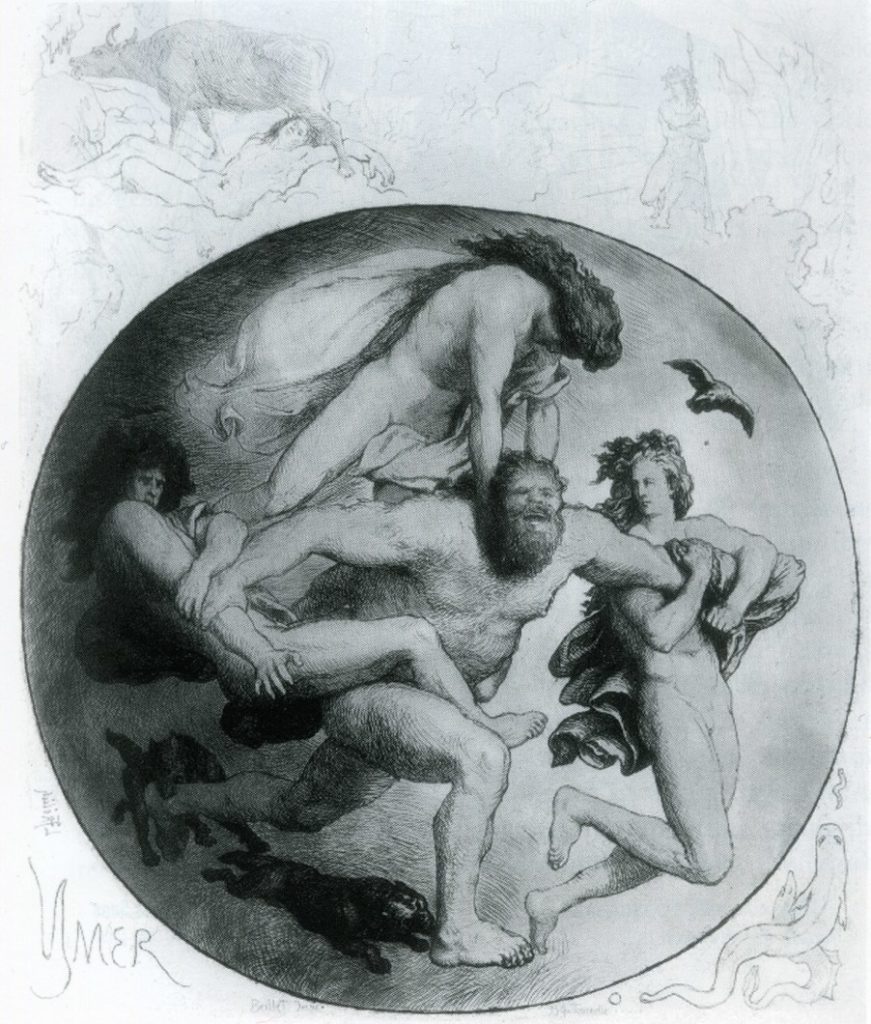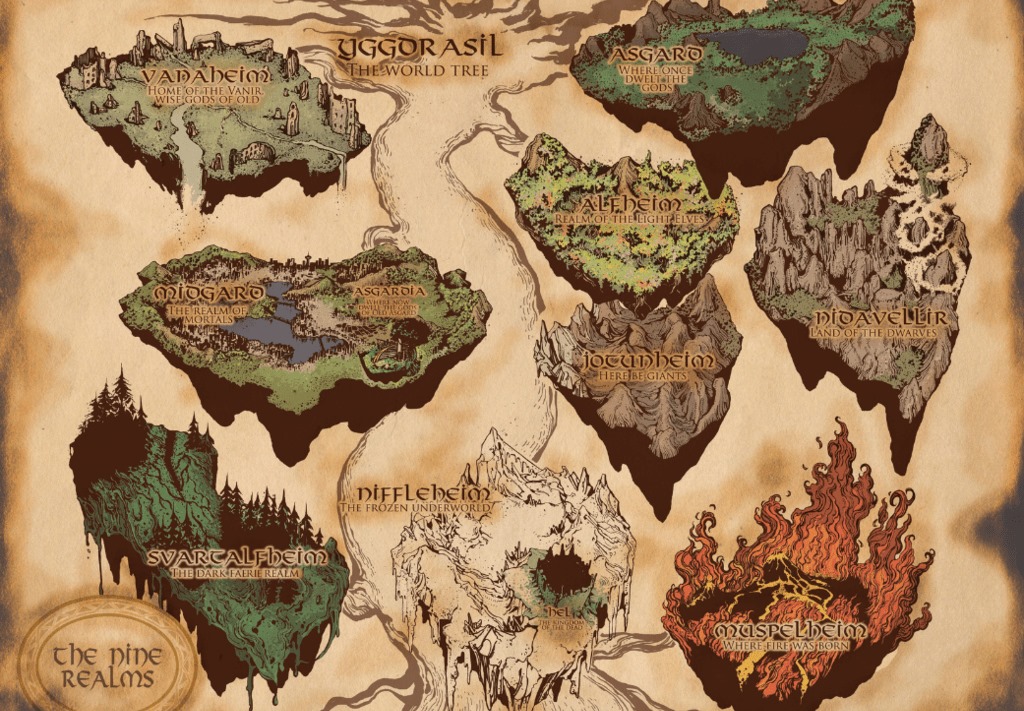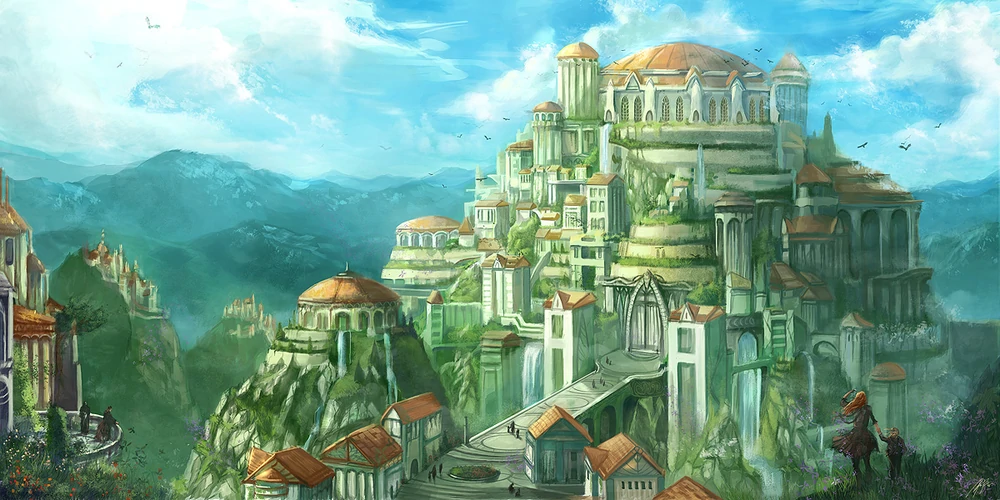In Norse mythology, Yggdrasil was the tree that connected the nine worlds. It was a massive ash tree sacred to the gods but simultaneously made of the fabric of reality. Yggdrasil was so important that it even had its god, Odin, responsible in some way for the creation of the nine realms.
Yggdrasil somehow connected each of the nine worlds, and the tree served as a bridge between them. With the Thor: Love and Thunder release, people have again taken an interest in Norse mythology, so it’s fitting to write an article on one of its most essential aspects, Yggdrasil.
In this article, we will discuss the mythological nature of Yggdrasil and the nine worlds associated with it. Like most cultures, Yggdrasil and the creation of the universe came from a singular event that shaped the world of Norse mythology.

What is Yggdrasil, and Where Did it Come From?
There is no one answer to this question, as the mythology of Yggdrasil is complex and varied. However, some common themes run through the various tales and legends. Yggdrasil, also known as the “world tree,” was said to be an immense, cosmic ash tree so large that you could not measure it; it was located at the center of the universe.
It stretched from the underworld to Asgard, the home of the gods. All of creation came from Yggdrasil and connected through its branches and roots. According to legend, Yggdrasil grew from a void called Ginnungagap, which was closed on either side by the fiery Muspelheim and the frosty Niflheim.
Where Did the Nine Realms Come From?
Yggdrasil was seen as a tree of life, connecting all the worlds in Norse mythology. You can identify it as a giant ash tree, with its roots stretching down into Niflheim (the land of ice and darkness) and branches reaching up into Asgard.
However, these worlds didn’t just exist when Yggdrasil grew from the void of Ginnungagap like a tree bearing its fruit. Lore tells of a different origin for the realms. When the flames from Muspelheim started to melt the ice caps of Niflheim, it created two higher entities: Ymir the Giant and Audhumla the Cow.
Yggdrasil and the Void: Ymir the Giant and Audhumla the Cow
Ymir is a primordial giant in Norse mythology, linked to the world’s creation and birth. A supernatural cow fed him with cosmic milk, and his bodily components became the universe’s building blocks.
An Icelandic scholar named Snorri Sturluson retold the myth of creation in the 13th century CE in a text called Gylfaginning (The Deceiving of Gylfi), which was part of more extensive work.
In these texts, Sturluson describes the event of creation where nothing but a giant void exists. The two opposites, Niflheim and Muspelheim, exist on either side of this void, and eventually, ice piles up in the gap where the rime meets the heatwaves from Muspelheim.

The resulting drops from the melting ice came together to form the being Ymir; Ymir is known as the ancestor of the giants. Then Ymir’s sweat gave birth to a male and female, and his legs also conceived a child.
The molten ice also formed another primordial being as it took the shape of a cow, Audhumla, who would feed Ymir. Audhumla’s diet came from the salt blocks of rime, and as a result, she had a child named Buri, who then had a son named Borr.
After Borr married a giantess named Bestla, they had three children named Odin, Vili, and Ve. Vili and Ve aren’t well known, but Odin would rise to a high seat in the divine world and be worshipped by all. Many considered him wise, pragmatic, strong, and a born leader.
Odin, Vili, Ve Shape the Worlds
For reasons unknown, Odin and his siblings murder Ymir the Giant and use his remains to shape the world as we know it. According to Norse mythology, when they killed Ymir, there was so much blood that it drowned the rest of the giants, except for one family.
The last giant family was that of Bergelmir and his wife, who later produced the giants that considered the gods their enemies. As Snorri retells the story, he mentions that the trio of siblings transported Ymir’s body to the void, made the earth from his body, and used his blood to make the seas and lakes.
The rocks came from Ymir’s bones, and the siblings created stone and scree from his teeth and the bones that were already broken. Ymir’s skull became the sky and was fixed with four points Austri (east), Vestri (west), Nordri (north), and Sudri (south). Finally, the trio made the stars from random sparks sputtering out of Muspelheim so they could provide light to the earth.
The gods constructed a fortification on the inside of the earth to defend the world against violent giants, and they used another piece of Ymir’s eyelashes for it. The barrier is known as Midgard (middle Earth), and it’s the world of humanity. At this time, Odin and his siblings also created the first two humans, Ask (man) and Embla (woman), from two trees.
The Nine Realms of Norse Mythology
With the world created, the nine realms came into being depending on the source, they were given different names, but they all agreed on nine. Believe it or not, nine is an important number to the Norse, often appearing in their mythology. The nine realms are as follows:
- Asgard
- Alfheim
- Vanaheim
- Midgard
- Muspelheim
- Niflheim
- Jotunheimr
- Hel
- Nidavellir/Svartalfaheimr
Let’s discuss these worlds briefly as they are all integral to the Norse belief system. Each world houses different beings with their unique purpose.

Asgard: Home of the Aesir and Vanir
At first, Asgard is said to have been part of the world of men, but Snorri places it in the sky, linked to Midgard by the rainbow bridge called the Bifrost. Asgard is home to the Aesir gods, who waged war against other gods known as the Vanir. They kept the peace and swapped hostages. Even though the Aesir primarily inhabits Asgard, there are Vanir who dwells there.

The Norse gods are Aesir or dwell in Asgard like Thor and Loki. Asgard is a heavenly city with lofty buildings encircled by a vast wall. Valhalla is the famed hall of Odin, where his throne may have sat.
Alfheim: Heavenly City of the Elves
The kingdom of Alfheim is also located in the heavens, not far from Asgard, and was home to light Elves after Snorri. It was governed by Freyr, a Vanir deity who was one of the hostages handed over from Vanaheim to Asgard as part of the peace agreement. The elves are fairies known to inspire art, music, and innovation.
Vanaheim: The Other Gods
The Vanir are a family of Nordic gods associated with fertility and magic. The Aesir went to war with the Vanir, but it’s unclear why. It’s possible the conflict was caused by the Vanir practicing incest and using a form of sorcery that the Aesirs considered unforgivable.
Whatever the reason, both sides reached a peace agreement in which hostages Njord, the Vanir sea god, and his two children, Freyr and Frejya, were moved to Asgard. Vanaheim is presumed to be a fertile and pleasant realm of enchantment and brightness.
The most well-known Norse goddess, Freyja – one of the most famous Norse gods – ruled over her kingdom of the dead in Asgard, known as Folkvangr (“Field of the People”). She may have had a similar environment to Vanaheim, her home realm.
Midgard: The Human Realm
After Odin, Vili, and Ve murder Ymir and create the Earth, they go for a stroll along the sea shore and discover two trees, an Ash and an Elm. So they form humanity from the Ash tree and women from the Elm.
On the other hand, the gods know these creatures are defenseless, so they create Midgard to defend them. First, they created the deep seas to dissuade the giants from bothering the humans, and the three siblings made the stronghold in Midgard from Ymir’s eyelashes.
Muspelheim: The Primordial Fire
According to Snorri, Muspelheim is the realm of fire, which was crucial in the formation of the world. The Fire-Giant Surtr resides here and will come out at Ragnarök to destroy Asgard and all of creation.
However, as with many original Norse ideas, Snorri’s version transformed Muspelheim’s identity. It has been known as a region of fire rather than an entity ever since.
Niflheim: The Primordial Ice
Niflheim, along with Muspelheim, is the oldest of the nine realms, the primordial land of ice and snow from which all life emanated. Snorri identified Niflhel with Niflheim and believed it was Hel’s realm. However, Niflheim is a cold, foggy realm where no one resides, not even the Frost Giants. Odin threw Hel into Niflheim giving her power over the dead and the lives in the Nine Realms.
Jotunheimr: Land of the Giants
Jotunheimr is the domain of giants and Frost Giants, located near both Asgard and Midgard. Many considered Jotunheimr a chaotic pre-civilization zone outside the discipline where magic and wild nature prevailed.
Loki, the god of mischief, was a Jotunheim native who spent his time in Asgard. Jotunheim is a dangerous location, but there are stories about gods from Asgard traveling to it on purpose.
Hel: The World of Darkness and Gloom
The gloomy region of Hel is ruled by Hel, the daughter of Loki and sister of the Midgard snake and Fenrir the wolf. When Loki’s children were born, he knew they would cause mischief, so he set them apart to do the least harm in each place.
He chained Fenrir down, put the Midgard serpent in the seas that surround the world, and consigned Hel to a subterranean hell beneath Yggdrasil’s roots.
Hel is described as a heavy and gloomy person, like a giant, not to be confused with the Hela in the Marvel film Thor: Ragnarök, played by Cate Blanchett. Her realm was initially associated with those who had died of battle or old age rather than disease or old age.
It was eventually the most crowded realm of the dead, and most people who died were assumed to go to Hel’s dark domain, where they drifted into a twilight-like state.
It is difficult to determine who went to Hel’s kingdom or why, as the great hero-god Baldr, among other things, is said to have gone there when he should have gone to Valhalla owing to his position.
Nidavellir: The Realm of the Dwarves
Nidavellir was situated deep underground in Midgard, and it was the home of the dwarves who worked there at their forges. It’s a dim, smoke-filled chamber lit by only the forge’s flames and the torches on the walls.
The dwarves were known for their craftsmanship and abilities with magic. The dwarves are also responsible for creating Thor’s hammer, Mjolnir, Odin’s spear, and the god Frey’s magic ship, which can be folded up and carried in his pocket.
Norse Mythology And Cultural Parallels
Norse mythology is rich in stories and cultural parallels. The tree of life, Yggdrasil, connects the nine worlds and symbolizes the cycle of life, death, and rebirth.
The gods represent different aspects of human experience, and you can interpret their stories in many ways. Gods like Aikaterina and Astarte are all like Ymir, a being that is a mother and a father.
One could speculate that several comparable figures from South Asian mythology also exist. Pangu, for example, was a giant who came from a cosmic egg and began creating the land, skies, valleys, and rivers.
You can find stories like this in Polynesia, Japan, or Kashmir. In Kashmir, the demon Rakshasa is killed, and his body is used to create a barrier using his leg and knee. Ymir created not only the giants but also the gods, as Odin’s mother was a giantess. Furthermore, Ymir’s tale reminds us of the critical link between giving up something and someone to create the universe through this sacrifice.
Yggdrasil And The Nine Worlds
These nine dimensions coexisted, worked together, and would continue to do so until the day of Ragnarök. The Norns – the fates – who wove human beings’ and deities’ destinies from their roots in Yggdrasil were independent of the Nine Realms and lived alongside them there.
Like the Three Fates of ancient Greek mythology, the Norn’s predictions were unchangeable, and no one could appeal their judgments.
Nothing could stop the nine realms from being destroyed. The universe falls, and the gods prepare for the ultimate conflict to preserve the ordered realm they constructed from the chaotic elements.
The gods will lose, but a few will survive the last battle, and a new world and new order of realms will grow from the ashes. This was the Norse religion’s goal: you could anticipate death and the loss of everything, but there was always something else. There was always hope for a new beginning.

